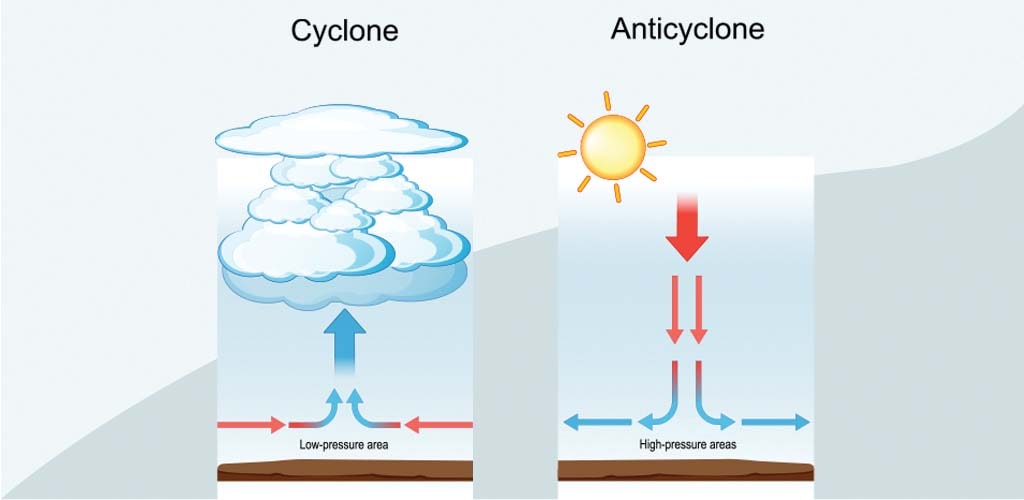What is a Cyclone?
By Nehal Jain |
Date 05-09-2023

Table of Contents
Admissions Open for
A cyclone, also known as a typhoon or hurricane, is a geographical phenomenon that occurs when high-speed winds travel in a circular motion around a low-pressure center. This intense circular storm originates over warm tropical oceans. It is characterised by low atmospheric pressure, heavy rainfall, and high winds.
Drawing heat from the surface of the sea and maintaining its strength as long as it remains over a warm water body, a tropical cyclone generates stormy winds that exceed 119 km per hour. In extreme cases, these winds may exceed the speed of 240 km per hour and surpass 320 km per hour. Every year during the summer months (July–September in the Northern Hemisphere and January–March in the Southern Hemisphere), cyclones strike the Gulf Coast of North America, northwestern Australia, eastern India and Bangladesh regions.
Accompanying strong winds are torrential rains, and a disastrous phenomenon known as the storm surge occurs. These high winds holding moisture make cyclones a severe hazard for coastal areas in tropical and subtropical regions.
Anatomy of a Cyclone
Tropical cyclones are circular storms that swirl around a central region of low atmospheric pressure. The hurricane winds are driven by this low-pressure core and the rotation of Earth, which results in the deflection of the path of wind currents known as the Coriolis Effect.
As a result, in the Northern Hemisphere, tropical cyclones rotate in a cyclonic direction (anti-clockwise), and in the Southern Hemisphere, it turns in an anticyclonic direction (clockwise).
The wind structure of a tropical cyclone is divided into three regions. First is a ring-shaped outer region; it has an outer radius of 160 km and an inner radius of about 30 to 50 km. In this outer region, the winds increase uniformly in speed and move toward the center. These winds speed to attain their maximum value at the second region-the eyewall, which is typically 15 to 30 km from the storm’s center. The eyewall surrounds the interior region, called the eye of the cyclone, where wind speeds decrease rapidly. The air in this region is often calm.
What are the Types of Cyclones?
There are four types of cyclones:
- Tropical cyclone
- Polar cyclone
- Mesocyclone
- Extratropical cyclone
Tropical Cyclone

Tropical cyclones are circular storms that originate in subtropical or tropical areas. This cyclone forms when the wind channels flow into a low-pressure disturbance. The flowing air condenses into clouds, and surface water evaporates to release energy. Tropical cyclones usually form between 5°- 30° degrees latitude. The temperature of the surface of the water body must be at least 80°
Tropical cyclones occur in the Eastern Pacific, North Atlantic (including the Caribbean), Southwest and North Indian Ocean, and Southern Pacific.
Types of Tropical Cyclones

- Tropical Depression: A tropical cyclone can sustain winds of 38 mph or less.
- Tropical Storm: This tropical cyclone can sustain winds with a speed of 39-73 mph.
- Hurricane: This tropical cyclone can sustain winds greater than 74 mph.
- Major Hurricane: This cyclone can sustain maximum wind speeds greater than 111 mph. The hurricanes would fall under categories 3, 4 and 5 on the Saffir-Simpson scale.
Polar Cyclone
In the Northern Hemisphere, polar cyclones are called “Arctic hurricanes.” The formation of this cyclone occurs when the latent heat is released when the heat is transferred from water to air due to condensation.
Polar storms are challenging to anticipate as they originate swiftly and last for less than 24 hours. They develop across the cold waters of the Arctic and Antarctic.
Mesocyclones
Mesocyclones are one of the most powerful tornadoes. These tornadoes are cyclonic and occur in supercells with updrafts. Mesocyclones are the vortex of air trapped between the convective storm and the base of the ground. This cyclone causes the creation of ‘wall clouds,’ which lead to the formation of a funnel of clouds. When the funnel cloud hits the Earth, it transforms into a tornado. Thousands of Mesocyclones occur each year, but only half of them are turned into cyclones.
Extratropical or Midlatitude Cyclones
Midlatitude or extratropical cyclones are cyclonic storms that occur near frontal boundaries in the middle latitudes. Unlike their tropical cousins, these cyclones are created when there are severe temperature differences between the connecting air masses. Midlatitude cyclones are typically bigger than hurricanes, despite having mild winds. A prominent example of this cyclone is the ‘nor’ easters that frequently occur on the American east coast in the winter.
Frequently Asked Questions
1) What is the Difference Between Hurricane, Typhoon and Cyclone?
Answer: Rotating storms when develop over the North Atlantic and North Pacific are called Hurricanes. When these storms are developed over South Pacific and Indian ocean are called Typhoon.
Also Read…
CBSE Schools In Popular Cities
- CBSE Schools in Bangalore
- CBSE Schools in Mumbai
- CBSE Schools in Pune
- CBSE Schools in Hyderabad
- CBSE Schools in Chennai
- CBSE Schools in Gurgaon
- CBSE Schools in Kolkata
- CBSE Schools in Indore
- CBSE Schools in Sonipat
- CBSE Schools in Delhi
- CBSE Schools in Rohtak
- CBSE Schools in Bhopal
- CBSE Schools in Aurangabad
- CBSE Schools in Jabalpur
- CBSE Schools in Jaipur
- CBSE Schools in Jodhpur
- CBSE Schools in Nagpur
- CBSE Schools in Ahmednagar
- CBSE School In Tumkur

Call Us to know more about Orchids
Swipe Up

.jpg&w=1920&q=80)














